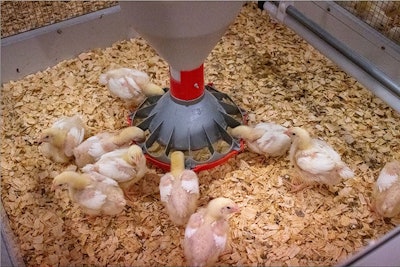
Specially designed lasers that periodically move throughout the floor of broiler houses stimulate the birds’ natural predatory instincts and activity, which helps improve animal welfare and meat quality.
“We started this project in 2017 and we’ve been working on it ever since,” said Elizabeth Bobeck, associate professor of animal science, Iowa State University College of Agriculture and Life Sciences.
“Every time we’ve run a live animal trial, we’ve had equal or better results with the lasers than without.”
Benefits of environmental enrichment
Lasers and other forms of environmental enrichment allow broiler chicks to demonstrate natural behaviors, such as the instinct to chase small insects.
An added benefit of lasers is that they don’t need to be cleaned and sanitized between poultry flocks, unlike other forms of environmental enrichment such as perches and platforms.
Benefits to meat quality
Playing with lasers could also positively impact meat quality.
“In initial trials, we found that it significantly improves the incidence and severity of woody breast,” Bobeck noted, adding that while they are still unsure of why this occurs, they believe it could be related to increased blood flow in the tissues.
Better weight gain, less stress
According to the project, birds exposed to the lasers consumed more feed and water, increasing weight gain, and walked more frequently than the broilers in the control group. In addition, the active group had fewer lesions, scratches and blisters than the control birds.
The lasers also seemed to lower the levels of serum corticosterone, a stress hormone.
“I was actually concerned that the chickens would lose weight because they were moving more, but they actually went to the feeder and got more water after playing with the laser,” added Bobeck.
The lasers used in the research was designed by Signify. USPOULTRY and the U.S. Department of Agriculture (USDA) National Institute of Food and Agriculture (NIFA) provided funding for the project.
The environmental enrichment is currently undergoing trials at a commercial facility.


















